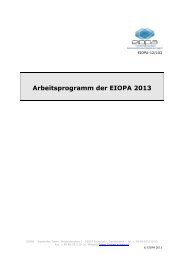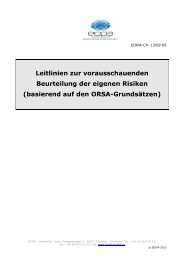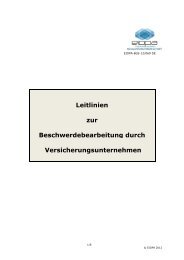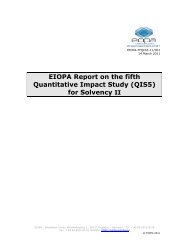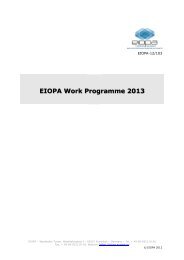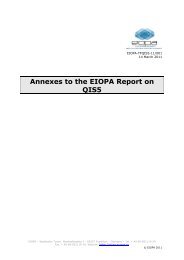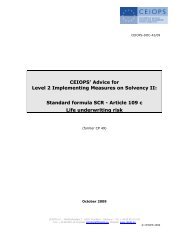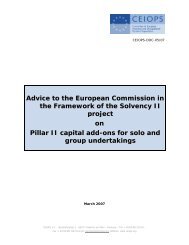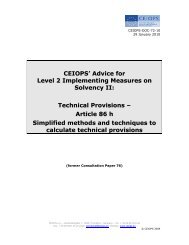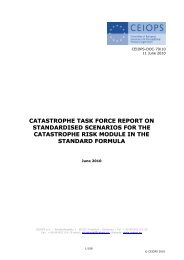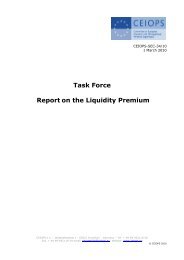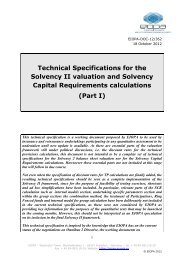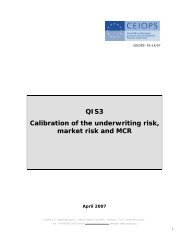Answers to the European Commission on the ... - Eiopa - Europa
Answers to the European Commission on the ... - Eiopa - Europa
Answers to the European Commission on the ... - Eiopa - Europa
You also want an ePaper? Increase the reach of your titles
YUMPU automatically turns print PDFs into web optimized ePapers that Google loves.
through a prescribed list. Lists are sometimes also easy <str<strong>on</strong>g>to</str<strong>on</strong>g> circumvent<br />
via asset transformati<strong>on</strong>.<br />
9.79 On <str<strong>on</strong>g>the</str<strong>on</strong>g> o<str<strong>on</strong>g>the</str<strong>on</strong>g>r hand, a list gives less room for interpretati<strong>on</strong> than broad<br />
principles, providing a more objective and enforceable safety net than<br />
principles al<strong>on</strong>e.<br />
9.80 A combined approach is suggested <str<strong>on</strong>g>to</str<strong>on</strong>g> retain <str<strong>on</strong>g>the</str<strong>on</strong>g> advantages of both<br />
principles and lists. In a combined approach, <str<strong>on</strong>g>to</str<strong>on</strong>g> be eligible, an asset<br />
must be both listed as eligible and meet <str<strong>on</strong>g>the</str<strong>on</strong>g> principles. One possible<br />
way <str<strong>on</strong>g>to</str<strong>on</strong>g> achieve this is <str<strong>on</strong>g>to</str<strong>on</strong>g> determine principles at <str<strong>on</strong>g>the</str<strong>on</strong>g> directive level,<br />
whereas a list of potentially eligible asset classes could be specified in<br />
implementing measures.<br />
9.81 Under ei<str<strong>on</strong>g>the</str<strong>on</strong>g>r a principles-based or list-based approach, asset eligibility<br />
could be c<strong>on</strong>sidered:<br />
• positively: setting out <str<strong>on</strong>g>the</str<strong>on</strong>g> universe of what is eligible (e.g.<br />
anything that meets a set of principles, or any asset that is listed<br />
is eligible; everything else is not); or<br />
• negatively: a prescribed list of assets or anything with particular<br />
characteristics is defined as being ineligible; everything else is<br />
eligible.<br />
9.82 Under a positive list-based approach, market innovati<strong>on</strong>s au<str<strong>on</strong>g>to</str<strong>on</strong>g>matically<br />
become ineligible when <str<strong>on</strong>g>the</str<strong>on</strong>g>y appear, whereas in a negative list-based<br />
approach <str<strong>on</strong>g>the</str<strong>on</strong>g>y are eligible until <str<strong>on</strong>g>the</str<strong>on</strong>g> list is updated.<br />
Criteria for eligibility and for updating <str<strong>on</strong>g>the</str<strong>on</strong>g> list of eligible assets<br />
9.83 In IAIS’s Corners<str<strong>on</strong>g>to</str<strong>on</strong>g>nes for Assessment of Insurers’ Solvency dated<br />
11 February 2005, Corners<str<strong>on</strong>g>to</str<strong>on</strong>g>ne V states that:<br />
"The [solvency] regime should require as a minimum that sufficient<br />
assets are available <str<strong>on</strong>g>to</str<strong>on</strong>g> cover <str<strong>on</strong>g>the</str<strong>on</strong>g> technical provisi<strong>on</strong>s and o<str<strong>on</strong>g>the</str<strong>on</strong>g>r<br />
liabilities."<br />
Future IAIS standards <strong>on</strong> assets covering <str<strong>on</strong>g>the</str<strong>on</strong>g> technical provisi<strong>on</strong>s<br />
should be c<strong>on</strong>sidered as a starting point for determining asset<br />
eligibility.<br />
9.84 Where <str<strong>on</strong>g>the</str<strong>on</strong>g>re is a very active market, <str<strong>on</strong>g>the</str<strong>on</strong>g> assets would au<str<strong>on</strong>g>to</str<strong>on</strong>g>matically<br />
meet any criteri<strong>on</strong> <strong>on</strong> realisability. But o<str<strong>on</strong>g>the</str<strong>on</strong>g>r assets would take l<strong>on</strong>ger<br />
<str<strong>on</strong>g>to</str<strong>on</strong>g> realise, for instance property assets might take 6 m<strong>on</strong>ths <str<strong>on</strong>g>to</str<strong>on</strong>g> a year.<br />
It may not always be possible <str<strong>on</strong>g>to</str<strong>on</strong>g> sell debts <str<strong>on</strong>g>to</str<strong>on</strong>g> third parties and in such<br />
cases <str<strong>on</strong>g>the</str<strong>on</strong>g> debt would have <str<strong>on</strong>g>to</str<strong>on</strong>g> be retained <str<strong>on</strong>g>to</str<strong>on</strong>g> maturity. As ano<str<strong>on</strong>g>the</str<strong>on</strong>g>r<br />
example, assets acquired for <str<strong>on</strong>g>the</str<strong>on</strong>g> purpose of <str<strong>on</strong>g>the</str<strong>on</strong>g> insurance business<br />
(e.g. furniture and fittings, office equipment or property occupied by<br />
<str<strong>on</strong>g>the</str<strong>on</strong>g> insurer) might be retained and written off (expensed) over <str<strong>on</strong>g>the</str<strong>on</strong>g>ir<br />
useful life (where market value is used <str<strong>on</strong>g>the</str<strong>on</strong>g> expense is <str<strong>on</strong>g>the</str<strong>on</strong>g> decline in<br />
market value): some items in this category should be regarded <strong>on</strong>ly as<br />
having value <str<strong>on</strong>g>to</str<strong>on</strong>g> <str<strong>on</strong>g>the</str<strong>on</strong>g> extent that <str<strong>on</strong>g>the</str<strong>on</strong>g>y can be used in meeting existing<br />
65



